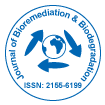当社グループは 3,000 以上の世界的なカンファレンスシリーズ 米国、ヨーロッパ、世界中で毎年イベントが開催されます。 1,000 のより科学的な学会からの支援を受けたアジア および 700 以上の オープン アクセスを発行ジャーナルには 50,000 人以上の著名人が掲載されており、科学者が編集委員として名高い
。オープンアクセスジャーナルはより多くの読者と引用を獲得
700 ジャーナル と 15,000,000 人の読者 各ジャーナルは 25,000 人以上の読者を獲得
インデックス付き
- CAS ソース インデックス (CASSI)
- 索引コペルニクス
- Google スカラー
- シェルパ・ロミオ
- Jゲートを開く
- Genamics JournalSeek
- アカデミックキー
- ジャーナル目次
- 研究聖書
- 中国国家知識基盤 (CNKI)
- ウルリッヒの定期刊行物ディレクトリ
- Global Online Research in Agriculture (AGORA) へのアクセス
- レフシーク
- ハムダード大学
- エブスコ アリゾナ州
- OCLC-WorldCat
- SWBオンラインカタログ
- パブロン
- ジュネーブ医学教育研究財団
- ミアル
- ICMJE
役立つリンク
オープンアクセスジャーナル
このページをシェアする
抽象的な
Characterization of Extracellular Polymeric Substances (EPS) Producing Bacteria Isolated from Biofilms Developed on Different Support Materials in Attached Growth Batch Reactors
Naeem Ali , Iqra Sharafat and Saba Ikram
Dewatering/sludge settling is the major problem that is being tackled by wastewater treatment plant. To overcome this problem, synthetic coagulants (environmental/health hazards) are used. In this contest, 50 bacteria (EPS producing capability) were selected, isolated from biofilms (different support materials). Congo red agar assay indicated 15 (slime producers), 24 (intermediate results) and 11 (non-slime) formers. Whereas tube method indicated 15 (strong), 15 (moderate), 12 (weak) slime and 8 (non-slime) producers. Microtiter plate assay showed 15 (strong) while 35 (moderate) biofilm formers. Dry weight analyses showed the greater concentration of broth (5.33-24.7 g/L) and slime EPS (1.33-13.33 g/L) in individual bacteria as compared to consortia broth (5.66-8.86 g/L) and slime EPS (3.22-6.57 g/L). EPS production was confirmed when an increase in viscosity (16,950-43,450 mPas) was measured. Over all carbohydrate content was higher in consortia (1.233-1.887 mg/ml) as compared to individual bacteria (0.504-0.610 mg/ml). Protein content varied in individual bacteria (0.227-0.52 mg/ml) as well as in consortia (0.178-0.974 mg/ml). FTIR spectra of EPS extract (bacteria and consortia) revealed the presence of functional groups of carbohydrates, proteins, lipids and nucleic acids. Great deal of EPS production was observed by consortia of six bacteria through SEM.

 English
English  Spanish
Spanish  Chinese
Chinese  Russian
Russian  German
German  French
French  Portuguese
Portuguese  Hindi
Hindi